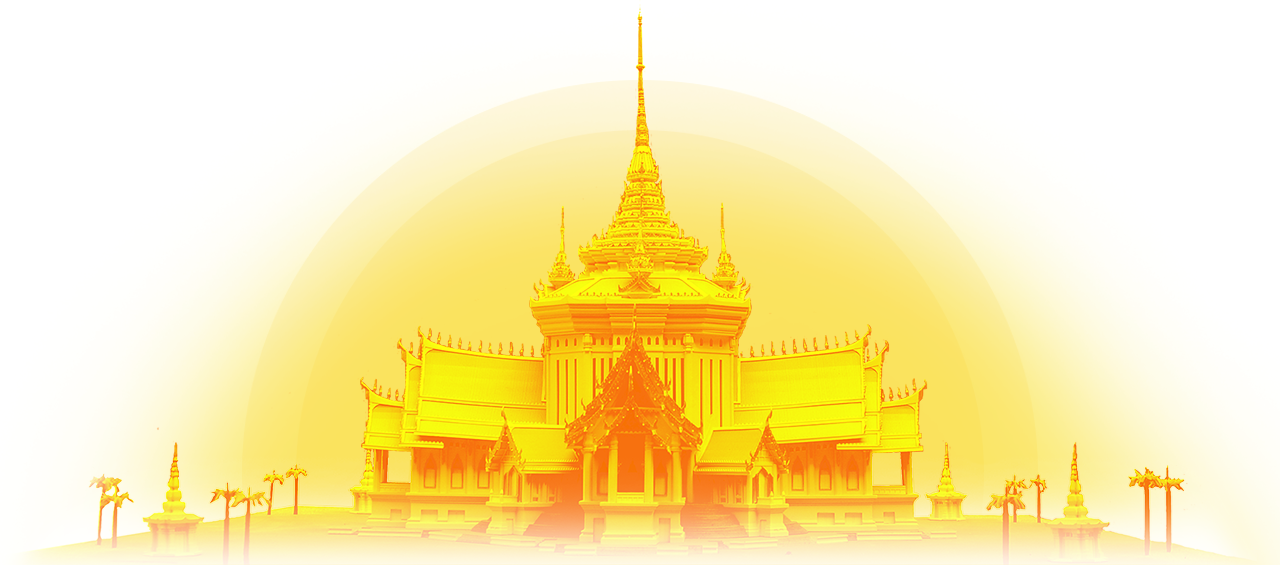- Home
- Meditation
- Vipassana Meditation
What is vipassana meditation?
Vipassana Meditation is the technique for developing Right Wisdom. This derives from contemplation of the four foundations of mindfulness (satipatthana), the physical body, feelings, mind, and dhamma (phenomena). It includes Right Wisdom with regard to the five hindrances, the five aggregates, the four noble truths, and the twelve links in the chain of dependent origination. (paticca-samuppada).
Vipassana meditation aims at developing the insight to see clearly and compare objectively the true nature of conditioned phenomena, such as the five aggregates, with the ultimate reality of the unconditioned phenomenon of nibbana or nirodha dhatu. It can be best achieved when the mind has already been trained to become pure and firmly concentrated through samatha meditation.
How many levels of vipassana?
There are two levels of vipassana. The first level is called preliminary insight (vipassana) meditation (anupassana). It is clear comprehension of the three universal characteristics of all compound phenomena – that they are impermanent, suffering, and non-self (that is, empty and meaningless). These characteristics must be understood in comparison with the opposite characteristics of non-compound phenomena which are eternal, supreme happiness, and ultimate reality. This is the first level of Insight Meditation.
The second level of insight meditation (also called supra-mundane Insight) is detailed contemplation of the four noble truths in three transcendent mental states (ñana): (1) Sacca-ñana or knowledge of the truths as they are, (2) Kicca-ñana or knowledge of the the functions with regard to the respective four noble truths, and (3) Kata-ñana or knowledge of what has been done with regard to the respective four noble truths.
In sacca-ñana, the meditator becomes able to see clearly and really know objectively suffering, the arising of suffering, the cessation of suffering, and the path leading to the cessation of suffering.
In kicca-ñana, he comes to know clearly what he is supposed to do with respect to each of the four noble truths. First, suffering (dukkha) should be gotten rid of; Second, the cause of suffering (samudaya) should be abandoned or relinquished; Third, the cessation of suffering (nirodha) should be clearly realized or penetrated; Fourth, the path (magga) should be entered upon, practiced, and developed.
Finally, in kata-ñana, the meditator sees clearly the progress that he has already achieved. This is gotrabhu-ñana or knowledge at the moment of change-of-lineage. From there, if the meditator can cut at least the first three fetters, which are false self-concept, doubt and reliance on ineffective rituals, he can immediately experience the non-compound nature of nibbana.
How to conduct preliminary vipassana meditation to comprehend the true nature of compound phenomena
Preliminary vipassana consists of insight into the three characteristics or common charateristics of all conditioned phenomena, which are impermanent (aniccang), suffering (dukkhang) and non-self (anatta).
Compound phenomena are made up of visible, physical components and invisible factors which influence birth and development. Everything in this world is compound. There are two main types of compound phenomena – living and non-living. We shall focus on living phenomena, which encompass all the characteristics and factors. Specifically, let’s focus on ourselves, understood as the five aggregates of body, sensation, memory, thought and recognition.
Like all compound phenomena, we are born, exist for a time, and then die and disintegrate. While in existence, we change, constantly, first growing and then degenerating. We exhibit the three universal characteristics of impermanence, suffering, and non-self. These three qualities are, in fact, only three different perspectives on the same trait – impermanence. With attachment, impermanence is experienced as suffering, because we are inevitably separated from what we love and united with what we detest. Similarly, impermanence implies “Non-self” in the sense of being void of real, permanent essence.
Our rebirth is fundamentally conditioned by ignorance. We want to be reborn because we love it here. It is nourished by the passions: greed or lust, hatred or anger, and delusion or misconception. These passions stimulate wholesome or unwholesome behaviors which produce either beneficial or harmful karmic consequences through actions, words and motives. Good actions, such as making merit, may result in fortunate births, but as long as ignorance remains, rebirth will continue. Three main factors govern our rebirth. They are Karma, consciousness, and craving.
Good or bad resultant karma (vipaka kamma), based on past actions, causes us to be reborn into the happy or suffering worlds. The happy worlds are the human, celestial, brahman and formless brahman worlds. They all provide substantial opportunities for further progress. The suffering worlds are the worlds of animals, demons, hungry ghosts, and hell beings. In these worlds, one is essentially cut off from opportunities for advancement, only paying off debts.
Our consciousness or cognition factor (viññana) determines what we can see and comprehend. It acts like a seed that flourishes throughout our growth and development. Our craving, whether wholesome or unwholesome, is the life force that propels germination and growth. This presentation has been a brief summary of conditioned genesis (paticcasamupada), which we will study in detail later on.
When a human being dies, it is the coarse human body that we see cease to function. The four mental aggregates and the refined human body, which are all transparent, along with the karmic accumulation from the last lifetime, constitute the microscopic nucleus for a new psycho-physical organism. They all depart together from the crude body as it passes away.
If its virtues, such as generosity (dana) and morality (sila), fall into the human range, the nucleus prepares for a human rebirth. It enters the body of the potential father, following the seven-step path that we learn in meditation, and comes to rest at the center of the body. Here, the nucleus can wait up to seven days. Its merits influence the father to have sexual desire for the mother. When the mental aggregates of the father, mother, and baby come together, a human force similar to gravity pulls the baby from the father into the mother as the sperm joins the egg. This is why our mental spheres are at the center of the body.
This is the original microscopic origin of the embryo. The four material essences (water, earth, fire and wind) develop into the crude meat and bones of the baby’s body, while the four mental elements remain perfectly still and pure, never opening the gate for passion. This is the initial development of the baby’s body and mind.
After birth, the remaining karma will function at its appropriate time. While growing up, the human mind always wanders outside and attaches to worldly objects, which may be good or bad, causing either wholesome or unwholesome effects. The mind may be stirred up or calm, stupid or wise, depraved or virtuous, leading to suffering or happiness. The physical elements (earth, fire, water, and wind) will be active in the young, causing growth, but less powerful in the elderly, causing the body to degenerate. The hair falls out, the teeth become loose, the skin becomes wrinkled, etc. Thus, we see that the body is impermanent, suffering, and unsatisfactory. In the end, it disintegrates and becomes non-self. In conclusion, we see that the body is void of any permanent, happy, self-essence.
How to conduct vipassana to compare compound and non-compound phenomena
We begin with four foundations of mindfulness meditation (satipatthana) to experience and contemplate the bodies-in-the-body, feelings-in-the-feelings, mind-in-the-mind, and dhamma-in-the-dhamma. The meditator develops jhana (mental absorption) to purify the mind from mental hindrances. Once the mind is pure and firmly concentrated, the meditator begins by contemplating the coarse physical human body, observing the five “root” (mula) meditation objects. These are the hair on the head, body hair, finger and toe nails, teeth, and skin.
Let’s take the hair on the head as an example. The meditator takes a single hair from the top of the head and examines it as though under a microscope at the center of the body. He sees the hair as it really is – impure and subject to change, in accordance with the factors influencing it, such as food and environment. With age, it naturally becomes less healthy and may turn grey or white. He or she notes that hair is impermanent. It may fall out, and will ultimately disintegrate, becoming no longer hair. It is, thus, impermanent (aniccang) and unsatisfactory (dukkhang). And, it is void of permanent reality or ultimate significance. It is, thus, “Non-self” or anatta, not the eternal self of anyone.
The same thing can be said for the hair on the body. Similarly, the teeth are impure – bathed in bacteria, smelly, subject to cavities, and apt to break and fall out. So, too, our nails need constant care – cleaning and clipping. The skin is always covered with sweat, needing to be bathed and have its stink covered over with perfumes. All of these body parts are impure, subject to change, unsatisfactory and potential sources of suffering. They are impermanent, without ultimate reality or meaning. This is the true nature of the whole body. From our birth as a baby, we develop until the prime of life, and then degenerate, growing old, suffering, becoming sick, and dying. After examining the physical body, the meditator continues with the four mental aggregates: sensation, memory, thought and cognition. Ultimately, this leads to clear comprehension that this whole psycho-physical organism is non-self (anatta).
Preliminary vipassana, thus, leads to comprehending the ultimate reality of the five aggregates as suffering and elucidates the cause of suffering as craving and attachment. When the meditator can let go, he can experience extinction of suffering, which is Gotarabhu-ñaña. If he meditates further, he may experience nibbana, which is non-compound and has the characteristics of eternal permanence, supreme peaceful happiness, and ultimate reality. He will, then, be able to compare the characteristics of compound and non-compound phenomena and realize the superiority and accessibility of the latter. This is right wisdom (pañña) which can eventually lead to enlightenment in the four noble truths.
What is satipatthana?
Foundations of Mindfulness, also called Satipatthana in Pali, consist of:
- Mindfulness of Bodies-In-Bodies
- Mindfulness of Feelings-In-Feelings
- Mindfulness of Minds-In-Minds
- Mindfulness of Dhammas-In-Dhammas
Lord Buddha said, “Whoever practices these four satipatthana for seven years can expect either immediate arahantship or the state of Non-returner (Anagami). ... Forget seven years, whoever practices these four satipatthana for seven months, can expect either arahantship or Non-returner status. ... Forget seven months, whoever practices these four satipatthana ...for only seven days can expect one of two results: Arahantship in this very existence or the state of Non-returner (Anagami). Thus, the four satipatthana are the one-way highway to the purification of the minds of beings, for overcoming sorrow and lamentation, for the cessation of physical and mental pain, for the attainment of the noble path, and for the realization of nirvana.
The Benefits of Developing Wisdom
There are hundreds of benefits gained from developing wisdom through meditation. A brief summary of these benefits is:
- The Destruction of Defilements,
- Attaining the Taste of the Noble Fruits,
- The Ability to Enter the Attainment of Cessation,
- Attaining Noble Qualities such as Being Worthy of Gifts.
Destruction of defilements is gained from discerning mind and matter as they really are. Knowledge of mentality and materiality begin with the benefits of developing worldly wisdom, but destruction of deep defilements and fetters such as False Self Concept (sakkayadihi) as well as attainment of the Path are the benefits of developing Supra-mundane wisdom.
Here are some similes showing how insight wisdom (vipassana-pañña) is able to destroy defilements:
- Like a lightning bolt that strikes a rock breaking it into fragments,
- Like a fire that consumes the forest,
- Like a ray of sunlight that destroys darkness.
The benefits of insight wisdom can be achieved and enjoyed only by the one who has developed them.
Attaining the Taste of the Noble Fruits: Attaining the taste of the Noble Fruits is also a benefit of developing insight wisdom. This is gained at two stages: When Noble Path consciousness arises and when Noble Fruit consciousness or cessation occurs. The Noble Fruit is the highest benefit of the Path. It has the eternal dhamma of nibbana as its object. It is a benefit of the highest and purest happiness, like tasting honey mixed with elixir.
The Ability to Enter Attainment of Cessation: Lord Buddha said, "Due to the wise causing Noble Wisdom [Noble Path and Fruit] to arise [through concentration and insight meditation], one enters the most refined attainment (samapatti) that the Noble Ones taste. This is considered reaching nibbana in this world. Thus, the Lord Buddha states that one who enters ultimate cessation (nirodha-samapatti), does so as the Fruit of Wisdom [wisdom development] in the Noble Paths."
Attaining Noble Qualities Such As Being Worthy of Gifts: The benefits of developing wisdom include not only the ability to attain cessation but also developing the qualities of the Noble Ones such as worthy of gifts. Generally, those who have developed wisdom are worthy of gifts (āhuneyya), hospitality (pahuneyya), offerings (dakkhineyya), reverential salutation (añjalikaraniya) of world beings and angels (deva) and are also an incomparable field of merit and virtue for the world. Specifically, there are four types of Noble Ones who have developed Supra-mundane wisdom.
- Stream-Enterer (Sotapanna): A Stream-Enterer (sotapanna) is one who has developed first path wisdom and abandoned the fi rst three fetters or bondages (sanyojana). As Lord Buddha states, "Here, monks, a monk in this dispensation is one fully accomplished in virtue but only moderately accomplished in concentration and wisdom. He infringes some of the lesser and minor training rules and then rehabilitates himself. Why is that? Because, monks, it is not said to be impossible for him to attain supra-mundane dhamma" (Anguttara-nikaya 20/280-283/415-419).
Regarding training rules that are fundamental to the holy life and in conformity with the holy life, his virtue is stable and steady. He trains himself in the training rules that he has undertaken. With the utter destruction of three fetters he becomes a Stream-enterer, no longer subject to rebirth in a lower world, fixed in destiny, with enlightenment as his destination.
Note: the Stream-enterer has entered the stream to nibbana and is not reborn into the lower realms, he is certain to become enlightened in the future. The three lower fetters are personality-view (sakkayaditthi) (the view that clings to mind and matter as self), doubt (vicikiccha) (in the qualities of the Triple Gems or the path leading to the cessation of suffering), and clinging to precepts and vows (silabbataparamasa). - Once-Returner (Sakadagami): The Once-returner (sakadagami) is one who has developed Second Path Wisdom (dutiya-maggapañña), abandoned the three lower Fetters and permanently weakened greed, hatred and delusion. The Once-returner will be reborn in this world only once before attaining Nibbana. As Lord Buddha states (415-419): "Here, monks, a monk in this dispensation is one fully accomplished in virtue but only moderately accomplished in concentration and wisdom. He infringes some of the lesser and minor training rules and then rehabilitates himself. Why is that? Because, monks, it is not said to be impossible for him to attain Supra-mundane dhamma."
Regarding training rules that are fundamental to the holy life and in conformity with the holy life, his virtue is stable and steady. He trains himself in the training rules that he has undertaken. With the utter destruction of the fi rst three Fetters and the attenuation of greed, hatred and delusion he becomes a once-returner. He comes back to this world only once more and then makes an end to suffering. - Non-Returner (Anagami): The Non-Returner (anagami) is one who has developed Third Path Wisdom (tatiya-maggapañña) and abandoned two more Fetters: sensual lust [desire] and repulsion [aversion]. The Non-Returner will not be reborn in this world. He will be reborn in the Pure Abodes in the Brahman world until attaining Nibbāna. As Lord Buddha states (415-419), "Here, monks, a monk in this dispensation is one fully accomplished in virtue, but only moderately accomplished in concentration and wisdom. He infringes some of the lesser and minor training rules and then rehabilitates himself. Why is that? Because, monks, it is not said to be impossible for him to attain the Supra-mundane dhamma."
But regarding training rules that are fundamental to the holy life and in conformity with the holy life, his virtue is stable and steady. He trains himself in the training rules he has undertaken. With the utter destruction of the five lower fetters he becomes a Non-returner, due to be reborn spontaneously and there attain final Nibbana, without ever returning to this world.
Note: The five lower fetters are personality-view (sakkayadihi), doubt (vicikiccha), clinging to precept and vows (sīlabbataparamasa), sensual lust (kamaraga), and repulsion (patigha). - A Worthy One (Arahant): A Worthy One is one who has developed fourth path wisdom and abandoned the last five higher fetters of attachment to pure form realms, attachment to formless realms, conceit, restlessness and Ignorance. The Arahant is far from defilements and has broken kamma (karma) and the cycle of rebirths. He is said to have disentangled all bondages during attainment of the Noble Path and to have completely disentangle them upon attainment of the Noble Fruit. He or she is worthy of veneration and respect of all people and is classed as the highest Noble Person in Buddhism. As Lord Buddha states, "Here, monks, a monk in this dispensation is one fully accomplished in virtue but only as yet moderately accomplished in concentration and wisdom. He infringes some of the lesser and minor training rules and then rehabilitates himself. Why is that? Because, monks, it is not said to be impossible for him to attain Supra-mundane dhamma."
As to those training rules that are fundamental to the holy life and in conformity with the holy life, his virtue is stable and steady. He trains himself in the training rules that he has undertaken.
With the utter destruction of mental intoxicants (asava), in this very life, he enters and dwells in the spotlessly pure liberation of mind, liberated by wisdom, having realized it for himself by direct knowledge.
As has been mentioned, the development of Noble Wisdom has many benefits; therefore, the wise person should strive to develop this Noble Wisdom. As Lord Buddha stated with the Dhamma principles of sila or morality, samadhi or concentration and pañña or wisdom, "A competent monk with the diligence and wisdom to cultivate himself who is firmly established in morality (sila) and development of mind (citta) and insight (pañña) meditation is able to slash through this thick underbrush [of passion]" (Samyutta-nikaya 15/61/20).
Note:
- The three lower fetters are personality-view (sakkāyaditthi) (the view that clings to mind and matter as self), doubt (vicikicchā) (in the qualities of the Triple Gems or the path leading to the cessation of suffering), and clinging to precepts and vows (sīlabbataparāmāsa).
- The five lower fetters are personality-view (sakkāyaditthi), doubt (vicikicchā), clinging to precept and vows (sīlabbataparāmāsa), sensual lust (kāmarāga), and repulsion (patigha).
- The five higher fetters are attachment to realms of form (rūpa-rāga), attachment to formless realms (arūpa-rāga), conceit (māna), restlessness (uddhacca) and ignorance (avijjā).




